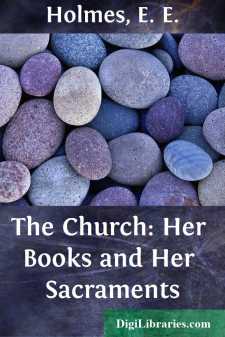Categories
- Antiques & Collectibles 13
- Architecture 36
- Art 48
- Bibles 22
- Biography & Autobiography 813
- Body, Mind & Spirit 142
- Business & Economics 28
- Children's Books 15
- Children's Fiction 12
- Computers 4
- Cooking 94
- Crafts & Hobbies 4
- Drama 346
- Education 46
- Family & Relationships 57
- Fiction 11828
- Games 19
- Gardening 17
- Health & Fitness 34
- History 1377
- House & Home 1
- Humor 147
- Juvenile Fiction 1873
- Juvenile Nonfiction 202
- Language Arts & Disciplines 88
- Law 16
- Literary Collections 686
- Literary Criticism 179
- Mathematics 13
- Medical 41
- Music 40
- Nature 179
- Non-Classifiable 1768
- Performing Arts 7
- Periodicals 1453
- Philosophy 64
- Photography 2
- Poetry 896
- Political Science 203
- Psychology 42
- Reference 154
- Religion 513
- Science 126
- Self-Help 84
- Social Science 81
- Sports & Recreation 34
- Study Aids 3
- Technology & Engineering 59
- Transportation 23
- Travel 463
- True Crime 29
The Church: Her Books and Her Sacraments
by: E. E. Holmes
Description:
Excerpt
THE CHURCH ON EARTH.
Christus Dilexit Ecclesiam: "Christ loved the Church"[]—and if we love what Christ loved, we do well.
But three questions meet us:—
(1) What is this Church which Christ loved?
(2) When and where was it established?
(3) What was it established for?
First: What is the Church? The Church is a visible Society under a visible Head, in Heaven, in Paradise, and on Earth. Who is this visible Head? Jesus Christ—visible to the greatest number of its members (i.e. in Heaven and in Paradise), and vicariously represented here by "the Vicar of Christ upon Earth," the Universal Episcopate.
Next: When and where was it established? It was established in Palestine, in the Upper Chamber, on the first Whitsunday, "the Day of Pentecost".
Then: What was it established for? It was established to be the channel of salvation and sanctification for fallen man. God may, and does, use other channels, but, "according to the Scriptures," the Church is the authorized channel.
As such, let us think of the Church on earth under six Prayer-Book names:—
(I) The Catholic Church.
(II) The National Church.
(III) The Established Church.
(IV) The Church of England.
(V) The Reformed Church.
(VI) The Primitive Church.
(I) THE CATHOLIC CHURCH.
The Creeds call it "the Catholic Church" and describe its doctrine as "the Catholic Religion," or the "Catholic Faith". The Te Deum, Litany, and Ember Collect explain this word "Catholic" to mean "the holy Church throughout all the world," "an universal Church," "thy holy Church universal"; and the Collect for the King in the Liturgy defines it as "the whole Church". The "Catholic Church," then, is "the whole Church," East and West, Latin, Greek, and English, "throughout all the world ".[] Its message is world-wide, according to the terms of its original Commission, "Go ye into all the world".
Thus, wherever there are souls and bodies to be saved and sanctified, there, sooner or later, will be the Catholic Church. And, as a matter of history, this is just what we find. Are there souls to be saved and sanctified in Italy?—there is the Church, with its local headquarters at Rome. Are there souls to be saved and sanctified in Russia?—there is the Church, once with its local headquarters at Moscow. Are there souls to be saved and sanctified in England?—there is the Church, with its local headquarters at Canterbury. It is, and ever has been, one and the same Church, "all one man's sons," and that man, the Man Christ Jesus. The Catholic Church is like the ocean. There is the Atlantic Ocean, the Indian Ocean, the Pacific Ocean: and yet there are not three oceans, but one ocean. The Atlantic Ocean is not the Indian Ocean, nor is the Indian Ocean the Pacific Ocean: they are all together the one universal ocean—"the ocean".
But, after all, is not this a somewhat vague and nebulous conception of "The Church". If it is to go into all the world, how, from a business point of view, is this world-wide mission, in all its grandeur, to be accomplished?...


